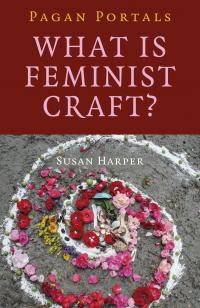

Americans don’t really have their own Goddesses. There are Native-American Goddesses, but because many modern Pagans are not of native descent, we often go to the Goddess stories of our heritage or, at the very least, what we are drawn to from other cultures. For many Goddess-worshippers, we have become very familiar with these figures and how they play a part in our lives and spirituality. They are recreated in statues sold in shops and on the internet, are illustrated in various depictions for stories and meditation cards, and are rewritten in many anthologies and blogs, their stories modified to fit a contemporary paradigm that wasn’t even an option in ancient times when they were first conceived. The theory is that while a wide variety of Goddesses are represented in America as part of Goddess worship, a generic depiction is beginning to emerge where many of the characteristics are blending, motherhood being one of the main attributes, and have replaced the vast differences of each feminine deity.
Goddess traditions in America have adapted, changed, or outright dismissed certain aspects of Goddess figures to suit their own needs. Other theorists see these changes as part of the natural evolution of earth-based religions and spirituality. As modern practitioners, it is essential that we discuss these changes and adaptations so that we can determine the possible effects of those changes.
To find the origins of many Goddesses is very difficult since many of them are an amalgamation of overlapping cultures throughout many centuries and within the context of an oral tradition. Certain elements are added, removed, or expounded upon based on possibly local factors or the individual storyteller’s preference. We have no way of knowing. What we can determine, however, is how the documented Goddess and her stories have been adapted to fit within the changing view of women in American culture and what that change has done to Her. This is in no way a negative critique of those changes, but an analysis of that change and a window into the repercussions of changing stories.
One of the first questions is to ask why these changes have even been made. Why is the Goddess rewritten? In an essay entitled ‘Contemporary Goddess Thealogy’, published in the volume Shaping New Vision: Gender and Values in American Culture, Emily Culpepper discussed the feminist view of the Goddess and how that vision has shaped her interpretation. This movement has propelled Goddess work and interpretation, but in the same light the sources pulled for these interpretations have been widespread and varied. Culpepper writes that, ‘Feminists interested in Goddesses regard almost any work as a potential source of information and catalyst for insight. None of them is completely adopted; they are freely explored and experimented with.’ In the same light, Goddess is difficult to define because part of her strength as a contemporary deity is that she can only be defined by those people who worship her. The Goddess is a combination of her attributes and what those attributes teach us as modern people and that, ‘For many a great many women, Goddess means a spectrum of female divinity, extending from the depth of the Self to the sense of a Divine Being who creates the universe.’ In another sense, she is often viewed as a channel in which we can reimagine our life and a sense of self.
If Goddess is viewed differently by so many individuals, then it becomes easier to see why and how her stories have been reconfigured and reimagined in so many different ways. Different retellings are not a contemporary construction; because these were oral stories from the beginning; the characteristics most assuredly were changed to meet the needs of the people telling the story and those listening. It has just become a more dramatic shift because we can trace the changes through the written publications.
Meeting the needs of the adherents is the most positive aspect of reimagined tales and Goddess interpretations. Goddess stories teach us. They help us to learn about her culture as well as our culture, and these stories help us to learn about ourselves, like how we could possibly handle complex and difficult situations. Even though the fantastical and magical elements of these stories are not realistic, the lessons sit right beneath the surface, even when the story is so far removed from our own contemporary American culture that a modern Pagan might have difficulty connecting with the lesson.
Adaptions are not new; they are a way to internalize these stories set in time periods that might be so foreign to what we know that it becomes difficult to understand context, and give us another avenue with which to learn. In that adaption, the story structure may change, characters might become less of what they were originally or what we know them to be originally, and even the lesson might change. It might change drastically. What we need to determine what those changes do to the Goddess and be aware of the changes that make in us.
Re-imagining a Goddess
One of my favorite modern interpretations of a Goddess story can be found in the Hindu tradition and has inspired countless people with this new vision. The actual impetus of story was finally documented in a blog post that took the Hindu Goddess Akhilandeshvari, one of the main forms of the Hindu goddess Parvati, and made her into a modern interpretation of a story that so many people can identify. She has become the ‘Never-Not-Broken Goddess’ from one poignant blog, entitled ‘Why lying broken in a pile on your bedroom floor is a good idea’ by JC Peters. Documented from a yoga instructor who took the story from oral tellings of his teacher, we have a truly modern interpretation of a little-known Goddess. Many people have baulked at this new interpretation because it is much removed from the original Goddess, what little we know of her, but her inspiration seems to stretch so far that she is recreated as a new almost separate Goddess for people to follow.
Source materials on Akhilandeshvari are very few and might be one of the reasons why her attributes and story are open for such dramatic interpretation. According to those sources she rides on the back of a crocodile and signifies our misdirected fear. Her imperfections are what help to strengthen her, as she is the one who does penitence for her wrongs.
Now, like the Never-Not-Broken Goddess, we have a stronger sense that we as people do not have to be put together all the time; in fact, we cannot grow unless we go through these periods of brokenness that allow us to mourn and then pick up the pieces of our lost souls and put them back together in a new configuration.
New adherents to this Goddess speak of her walking beside them as they continually heal from the fracturedness of the world. They wish to connect with her through tattoo work, something that many Pagans see as a very real and sincere form of devotion. Mental health specialists have taken Akhilandeshvari’s new message and connected it to their work with those people who are stuck in depression and need a way to help them re-examine their lives and move out of that fractured existence.
The Softening of Frightening Features
Not all retellings of Goddesses and their stories are so dramatically different, but there are those Goddesses who lend themselves to a reshaping, especially if their homeland is vastly different from what we find in the United States. Yemaya is one such Goddess.
There are several visions of Yemaya throughout the world before she even set foot on the North American continent. She is known in the Yoruba tradition, Cuba, and Brazil in different variants of the Afro-American oral tradition. Her attributes are similar in these countries, but they do pose some differences that lend themselves to various interpretations. Because she is an orisha, she embodies an aspect of nature, in this case the ocean. Like the ocean, Yemaya can be comforting and embracing, but also like the ocean her depths run very deep. Storms can brew suddenly and become violent. This aspect of Goddess is difficult for many modern American audiences to embrace. We prefer our deities loving at all times and not something to fear. Yet, these older versions show a side of life that is just as tangible and important, maybe even more so because they teach us the stark realities of the world.
In most views, Yemaya is the fierce protector of her children, a mother who embodies a strong sense of fortification and instills fear in anyone who threatens those she loves. Anyone who knows this type of mother, is well aware of what that protective spirit can look like, depending on which side of the situation you sit.
When we step outside of these traditions, Yemaya still holds a place among the Goddesses, but she sometimes looks a little different. Her features are soft and the kind and nurturing characteristics are highlighted much more than her fierce protection. She is revered for her loving nature, but not feared for her wrath. As such, several depictions of her are warm and inviting and often stir up different emotions than those considered part of her traditional aspects. Yemaya is a mother goddess, the goddess of home, fertility, love and family. Like water she represents both change and constancy – bringing forth life, protecting it, and changing it as is necessary. Even in a recent Beyonce video we see the softened Yemaya symbolism in the blue and white colors, the flower offering in the water, and the tribute to motherhood alongside the Virgin Mary.
Arianrhod Becomes the Misunderstood Mother
Even in European Goddesses we see an often dramatic change in persona. This is the case in the Welsh Goddess Arianrhod who, in original stories, is a mother who attempts to destroy her son on several instances because she is ashamed of his existence.
This story in the Mabinogi began with Math, who was looking for a new virgin to be his footholder and confidant. Arianrhod revealed that she was a virgin, but did not want to oblige as her uncle’s servant. Math tested her word with magic and a child fell from her womb. The child grew instantly and ran to the sea. A second boy was born and Arianrhod’s brother Gwydion scooped him up and ran away with him to raise as his own. As the boy grew, Arianrhod refused to give him three necessary things that were traditional gifts from a Celtic mother: a name, arms, and a wife. Therefore, Gwydion and the boy tricked Arianrhod into giving the boy a name (Llew) and duped her into arming him for battle. They were not successful, however, in getting a wife for the boy. Math and Gwydion then cooked up a plan to create a wife out of flowers, and thus begins the story of Blodeweudd. In the end, Llew endured a painful transition in order to seek salvation.
The original story gives us a picture of an unfeeling mother; however, the story can also be interpreted another way, past all the layers of cultural implications and possible misinterpretations.
Modern retellings of the Arianrhod tale have taken a more feminist stance on her story. The three tricks that her uncle and brother performed as punishment for turning away from her son, become three trials that Arianrhod deliberately sets up so that her son, Llew, can become a man. This modern interpretation does not necessarily alter the story, but allows the reader to view the Goddess in a more sympathetic light, one where we begin to see her true motivations. Most characters, be they Gods, Goddesses, heroes, or heroines in Celtic lore have to go through tests or transformations in order to learn or become fully realized. Arianrhod, the Goddess of the divine spark of life, the energy that drives every one of us, was pushing her young son to succeed through many tests. Through cunning and creative thought, he gained those items necessary to become who he was. He also learned that you cannot fashion a woman for yourself, but allow a mate to come to you, if one chooses to do so.
Arianrhod is an aspect of the mother who pushes her children to try for themselves and to even fail, if that is something they need to endure. She was always there to catch Llew; he did not die from the wounds like he thought, but instead shed misconceptions that he held in order to become whole again. These were his trials and a good mother would allow him to get hurt just enough that he would learn from those trials.
Moyra Caldecott’s retellings of Women in Celtic Myth is one such transformation that highlights a different vision of Arianrhod from a woman duped by her family to give her son what is due to him, to a mother carefully guiding her child to adulthood. Caldecott described this interpretation clearly in the end of the story saying, ‘Arianrhod, in her remote castle by the silver sea, was well content that her son has passed through all the tests she had set for him and had become a strong and wise man.’
Implications in Goddess Retellings
Discussions brew around the implications of these retellings, whether moving away from the origins of the tale and the descriptions of the Goddess are detrimental to the tradition or to the Goddess herself or whether they become watered down versions of something richer and more dynamic. In addition, many visual drawings illustrate a more sexualized version of Goddesses, even those whose attributes do not necessarily focus on fertility and love. While these drawings often soften the intimate details of fertilization, some revisions play up the sexual aspect of the seasons to the point of making it an erotic depiction. This creates another layer of implication, especially as America continues our obsession with sex. This is a longer conversation, one that also examines how the retellings have made these Goddesses more relevant to our contemporary lives, and isn’t that we imagined the ancient people doing as well; recreating and reimaging, integrating what lessons work within the context of history and culture.
In addition, these changes do not just happen in the US. Retellings, reimaginings, and reinterpretations are not an American construction, but because of our continuing fascination with Goddess lore, we are the most visible in these changes. At a time when Americans are often faulted for damaging cultural stories and conventions, perhaps this might be one area where those changes could be beneficial for those who are using the stories for their own instruction, as long as the origins also remain and are not lost to the centuries of forgotten stories. History, especially ancient history and oral storytelling is not clean and neat. It is very messy and years between translations and visual interpretations can add to the murkiness and nuance of these Goddesses. All deities can change, morph, and transform to accommodate new visions. While there is much to discuss about how those differences might erase what we can only presume as the original intention, we might also look at the new version and see what it can also offer us.
Margo Wolfe is an educator, writer, and member of the Sisterhood of Avalon. She co-ordinates many local events for adults and teenagers, including a Teen CUUPS (Covenant of Unitarian Universalist Pagans) group in PA. Her forthcoming book is entitled, Turning the Wheel and Mentoring our Pagan Youth: A Curriculum Guide for Instructors of Pagan Teens.
Categories:
0 comments on this article






